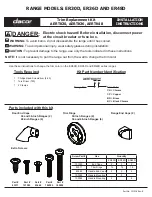
Instructions for the user
87
9.7
Removing the door seal (not on pyrolitic models)
To permit thorough cleaning of the oven, the
door seal may be removed.
There are fasteners on all four sides to attach it
to the edge of the oven. Pull the edges of the
seal outwards to detach the fasteners. The seal
must be replaced when it loses elasticity and
hardens.
9.8
Cleaning the door seal
To keep the seal clean, use a non-abrasive sponge and lukewarm water. The
seal should be soft and flexible (with the exception of pyrolitic models).
In pyrolitic models, the seal may flatten over time and lose its original shape. To
restore it, pinch the seal all the way along its perimeter. This also helps remove
any dirt on the seal.
9.9
Cleaning self-cleaning panels (catalysis cycle)
If the self-cleaning panels are dirty, primarily with
small amounts
of grease, a
heating cycle can be executed to regenerate them.
Clean the base and the roof liner first with a microfibre cloth soaked in water and
neutral washing up liquid, then rinse thoroughly.
Set a regeneration cycle by selecting a fan-assisted function at the maximum
temperature for one hour.
If the panels are
particularly dirty
, after the regeneration cycle, remove them
and wash them with neutral washing up liquid. Then rinse and dry them.
Put the panels back in the oven and set a fan-assisted function at a temperature
of 180°C for one hour, in order to ensure that they are thoroughly dry.
We recommend carrying out the self-cleaning panel regeneration cycle every 15
days.
The panel regeneration cycle is a cleaning method suitable for grease residues,
not sugar-based ones.
















































